Kentucky Pesticide Safety Education Program

Questions?
Contact
Dr. Ric Bessin
Dept. of Entomology
University of Kentucky
859-257-7450
rbessin@email.uky.edu
Visits since 11/11/16
Weeds
Weeds are plants that are growing where they are not wanted. Usually, they cause minimal problems in healthy, vigorously growing turf. However, weeds can out-compete desirable turf due to poor management practices: irrigation, fertilization, mowing, turf diseases, insects, or from heavy use. Weed free turf is not practical in most cases but a balanced management program can keep them to a minimum.
A typical weed has one or more of the following characteristics:
- Produces lots of seed
- Populations establish rapidly
- Seeds can lie dormant for a long time
- Have vegetative reproductive structures
- Adapted for easy spread
- Plant development stages
Plant Development Stages
Most plants undergo four stages of growth and development.
- Seedlings emerge from the soil soon after germination.
- Leaves, stems, and roots grow rapidly during the vegetative stage, water and nutrient demands are relatively high.
- After a period of vegetative growth, the plant enters the reproductive stage where most of the energy production in the plant is devoted to seed formation. Seed production is critical for survival of annual and biennial species.
- Little or no energy production occurs during maturity when seed production is nearly finished. During this stage, the plant typically sheds its seeds and dies.
Plant Classification
Weeds can be grouped into the following categories:
- grasses
- sedges
- lilies
- broadleaves.
 Grasses have only one leaf as they emerge from the soil. Their leaves are two-ranked and typically upright, narrow with parallel veins. Grass stems are round and hollow. The root system of a grass is fibrous with the growing point located at or below the soil surface (surrounded by several layers of leaves). Perennial grasses can produce new shoots from growing points located on rhizomes (belowground) and/or stolons (aboveground).
Grasses have only one leaf as they emerge from the soil. Their leaves are two-ranked and typically upright, narrow with parallel veins. Grass stems are round and hollow. The root system of a grass is fibrous with the growing point located at or below the soil surface (surrounded by several layers of leaves). Perennial grasses can produce new shoots from growing points located on rhizomes (belowground) and/or stolons (aboveground).
Sedges resemble grasses but they have triangular stems with three rows (ranks) of leaves. Typically, sedges are listed under the grass section of an herbicide label. They prefer moist, poorly drained soils, but can grow in fertile, well-drained soils. Yellow nutsedge, is a perennial that reproduces by tubers and rhizomes. It is the principle sedge found in Kentucky.
Lilies resemble grasses and sedges but they have long, linear leaves and reproduce from underground bulbs. Two common species found in Kentucky are wild garlic and Star-of-Bethlehem.
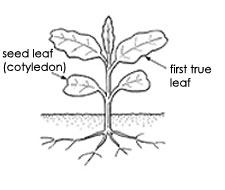
Broadleaf seedlings have two leaves (cotyledons) as they emerge from the soil. The leaves are generally broad with net-like veins. Broadleaves typically have a taproot surrounded by a relative coarse root system. Actively growing broadleaf plants have exposed growing points at the end of each stem and in each leaf axil.
Perennial broadleaves may have growing points on roots and stems above and below the surface of the soil.
Plant Life Cycles
Annual plants complete their life cycle in one growing season, often in as little as 45 days. Biennials require two seasons. Perennials grow for three or more years.
Annuals that grow from spring to fall (large crabgrass and goosegrass) are summer or warm-season annuals. These are often problems because their life cycle is the same as many crops. Those that grow from fall to spring (common chickweed and henbit) are winter or cool-season annuals.
Biennial plants complete their life cycles over two growing seasons. Most start from seed in the fall or spring and grow through the summer, fall, winter, and following spring. They overwinter as rosettes. In the second summer, biennials flower and die. Examples include wild carrot and musk thistle.
Perennials often are the most difficult weeds to manage. Woody species generally go dormant in the winter and begin growth in spring from aboveground stems. Aboveground parts of herbaceous perennials may die back, but their underground storage organs survive the winter. Many are deep rooted so they continue to grow during summer droughts. Perennials can spread from seed and often from roots, tubers, bulbs, and rhizomes. White clover and yellow nutsedge are examples. Dandelions can be annual or perennial.
Many weeds produce large quantities of seeds that are easily carried by wind, rain, machinery, animals, and people. Weed seeds can germinate after being dormant for long periods of time. They also can tolerate extremes in weather such as temperature and moisture. It is best to control weeds before they produce seeds.
Summer Annuals
photo: Lynn Sosno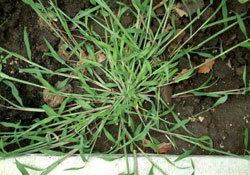 skie, Univ. of Georgia, Bugwood.org
skie, Univ. of Georgia, Bugwood.org
Crabgrass
From seed and roots at lower joints; encouraged by alternating wet, dry soil surface in spring; germination begins mid-April; 3 to 10 finger-like branches at top of stem; thrives in sparse turfgrass stand; low mowing; heavy traffic area; full sun
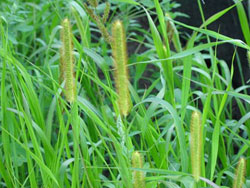
photo:University of Minnesota
Foxtail
Bright green clumping grass; heavy traffic areas; bushy, cylindrical seed head at top of stem; full sun; low mowing
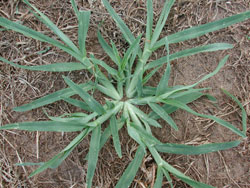
photo: Michigan State University
Goosegrass
Germinates May to June; prostrate growth; white center with wagon-wheel appearance; sparse turfgrass stand; low mowing; grows well in compacted soil

photo: Lynn Sosnoskie, Univ. of Georgia, Bugwood.org
Common knotweed
Germinates in early spring; prostrate growth; alternate, oblong, pointed leaves; heavy traffic; along roads or driveways
Winter Annuals
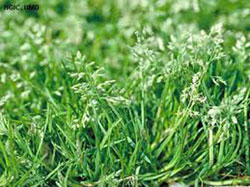
photo: University of Maryland
Annual bluegrass
Germinates from fall to early spring; light green bunch-type grass with flattened stems; can produce seed heads even with low mowing heights; irrigated turf and moist shade

photo:Michigan State University
Common chickweed
From seed in autumn and creeping stems; pairs of smooth, egg-shaped leaves; small star-shaped white flowers
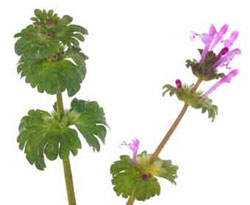
photo:Oklahoma State University
Henbit
From seed and roots form lower joints; square stem that branches close to ground; almost circular opposite leaves with rounded teeth or lobes; prefers moist soil in shade
Perennials
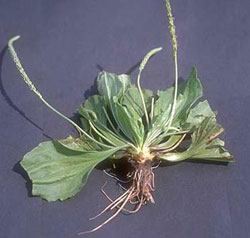
photo:Purdue University
Broadleaved Plantain (Purdue)
From seeds and new shoots from taproot; leafless stem; egg-shaped leaves; seeds along half length of seed stalk; thrive in weak, thin turf
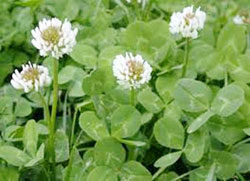
photo:Kansas State University
White clover
From seed and creeping stems; creeping growth; white blossoms; leaves with 3 leaflets; survives close mowing
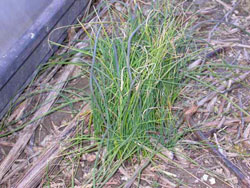
photo:Missouri Botanical Garden
Wild garlic (Mo. Botanical Garden)
From underground bulbs and aboveground bulblets; round slender leaves are hollow; poorly maintained or thin turf
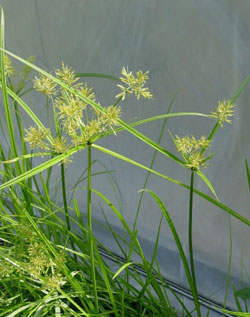
photo: Mark Czamota, Univ. of Georgia, Bugwood.org
Yellow nutsedge
From seed, rhizomes, and tubers; fast growing; yellow-green triangular stem; often in wet soil
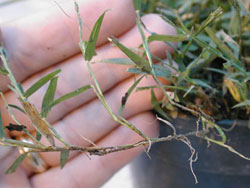
photo: msuturfweeds.net
Warm season perennial, stolons root at nodes producing dense stands. Leaf blades gray-green with loose-spreading growth. Especially common in Kentucky bluegrass. Mowing is not an effective control measure.
Perennial or Annual

Common dandelion
From seeds and root shoots; stems contain a milky juice and arise from a long, thick, fleshy taproot

photo: Rob Routledge, Sault College, Bugwood.org
Wild violet
From seed and underground root; heart-shaped leaves; often grow in shade
[return]
1) ________ plants germinate in the spring, grow, mature, produce seed, and die in summer or early fall.
2) ________ plants appear in the fall and die in late spring or early summer of the following year.
3) Annual plants are easiest to control in the _______ stage.
4) The _______ stage of plant development is characterized by rapid uptake of water and nutrients and fast growth.
5) Biennial plants are easiest to control in the _______ stage.
6) Removing the aboveground vegetation will stop perennial plants from spreading in a field.
7) ________ plants can reproduce by stolons, rhizomes, tubers, or bulbs.
8) The rosette stage is part of the live cycle of a _________.
9) Which of the following is not a form of vegetative reproduction of a weed?
10) Crabgrass _______________.
- is a winter annual with a bushy seed head
- is a summer annual with 3 to 10 finger-like branches at the top of its stem
- is a perennial plant
- has a square stem
11) Common knotweed ___________.
- grows in low-lying wet areas
- grows in areas compacted by heavy traffic
- is a perennial plant
- has a bushy, cylindrical seed head at the top of stem
12) Annual bluegrass ____________.
- is a light green bunch-type grass that can produce seed heads even with low mowing heights
- has egg-shaped leaves and small star-shaped white flowers
- has a prostrate growth form and a white center with a wagon-wheel appearance
13) __________ has a yellow-green triangular stem and grows in wet soil.
14) An emerging _______ plant has 2 seed leaves.
15) Annual plants reproduce from underground stems and tubers.
16) It is best to control weeds before they produce seeds.
17) The growing point of a grass is always above the soil surface.
18) All actively growing ________ have exposed growing points at the end of each stem and in each leaf axil.
19) ________ usually have a taproot and a relatively coarse root system.
website content by L. Townsend website design by P. Dillon copyright © 2016 University of Kentucky Department of Entomology
University of Kentucky College of Agriculture |
S-225 Agricultural Science Center North, Lexington, KY 40546-0091 | 859.257.7450
An Equal Opportunity University |
Last modified
11/30/2018
